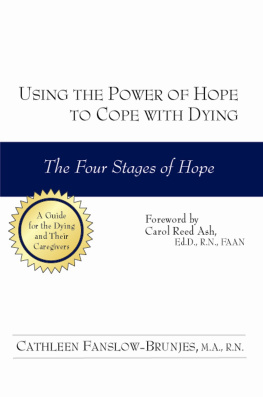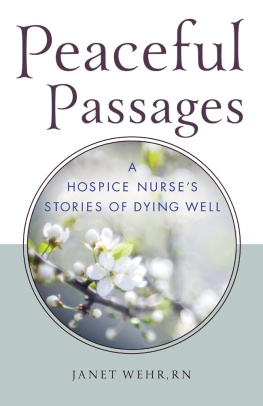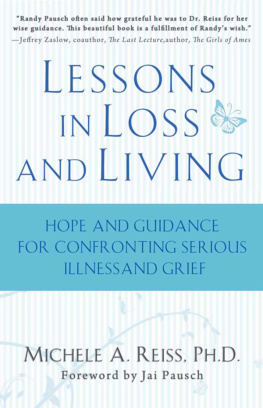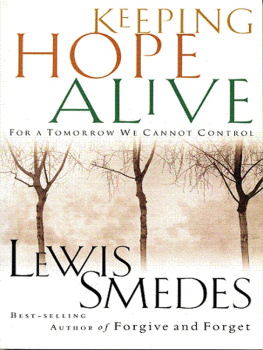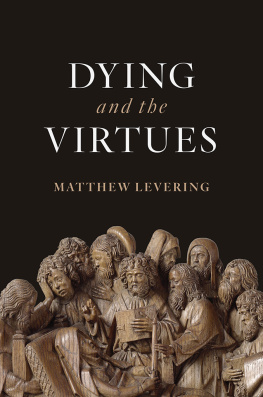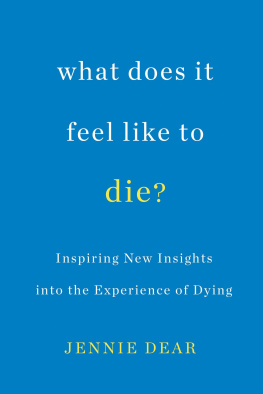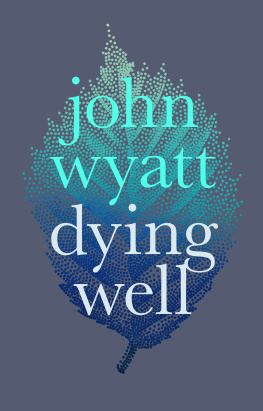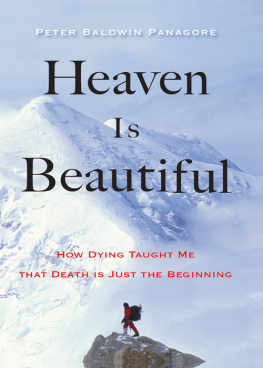Praise for
Using the Power of Hope to Cope with Dying
This potent and inspiring message is highly recommended for both the professional and the nonprofessional end-of-life caregiver.
Dolores Krieger, Ph.D., R.N., author of Therapeutic Touch as Transpersonal Healing
When a person is dying, the sense of having lost all hope is often worse than the prospect of death; this book is an antidote to hopelessness.
Ira Byock, M.D., palliative care physician; author of Dying Well and The Four Things That Matter Most
Hope is necessary for survival. It is not about statistics and there is no false hope. This book gives the reader an excellent perspective about the role hope can play in ones life while confronting ones mortality. You can learn to live until you die rather than be dying.
Bernie Siegel, M.D., author of Love, Medicine & Miracles and Help Me to Heal
I have just finished reading your manuscript.... It is an interesting and moving contribution to the huge literature on death.
Elisabeth Kbler-Ross, M.D., author of On Death and Dying, who got a chance to read the working manuscript for this book prior to her own death in 2004.
Rabindranath Tagore, the great Indian poet, said, Hope is the bird that sings before the dawn. In this wonderful book, Cathleen Fanslow-Brunjes helps us recognize this song so we can harmonize with it. It is when the darkness is the most profound that hope emerges as the true reality. She gives us tools which we can use to create the music of love which each soul needs.
Gladys Taylor McGarey, M.D., M.D.(H)., Founder and Past President of the American Holistic Medical Association
To my father,
without whom I would not be who I am,
and to my three teachers:
Dolores Krieger, Ph.D., R.N.;
Elisabeth Kbler-Ross M.D.;
and Dora Kunz
Copyright 2008 by Cathleen Fanslow-Brunjes
All rights reserved.
Printed in the United States of America.
Published by
Quill Driver Books, an imprint of Linden Publishing
2006 S. Mary, Fresno, CA 93721
559-233-6633 / 800-345-4447
QuillDriverBooks.com
Quill Driver Books titles may be purchased for educational, fund-raising, business or promotional use. Please contact Special Markets, Quill Driver Books, at the above address or phone numbers.
Quill Driver Books Project Cadre:
Doris Hall, Christine Hernandez, Dave Marion,
Stephen Blake Mettee, Cassandra Williams
First Printing
ISBN 978-1-610350-24-2
To order a copy of this book, please call
1-800-345-4447.
Library of Congress Cataloging-in-Publication Data
Fanslow-Brunjes, Cathleen, 1939
Using the power of hope to cope with dying : the four stages of hope / by Cathleen Fanslow-Brunjes.
p. cm.
ISBN 978-1-610351-7-68
1. DeathPsychological aspects. 2. HopePsychological aspects. I. Title.
HQ1073.F36 2008
155.937dc22
2008003483
Contents

Hope is the thing with feathers
that perches in the soul
and sings the tune without the words
and never stops at all...
Emily Dickinson

Foreword

H ope is a powerful word. It is a word used by all of us in many different ways and with many different meanings. The American Heritage College Dictionary defines hope in one way as to wish for something with expectation of its fulfillment, to expect and desire. But hope is different from wishing for something or being positive about events in your life, whatever form those events may take.
Hope is everywhere. Think about your family and your friends. Recall the way in which each one has dealt with lifes experiences. Every one of us has our own way...a story about how we hope and what hope means to us. Hope is an integral part of our life and follows us as we experience life and death. It gives us a way to deal with what has happened to us.
This book, authored by my longtime friend and colleague, Cathleen Fanslow, is about helping those facing death, something many fear and do not wish to think about. It provides a powerful tool to help the dying and their family and loved ones cope with the inevitable act of dying. Those of us who began our careers in the early sixties and continue to practice today have seen many changes in the way health care is practiced and death is addressed.
This book about using the power of hope to cope with dying evolved from the authors many years of personal experiences caring for the sick and terminally ill. It draws on both what patients taught a young practitioner before the days of hospice care and on the approaches to terminal care available today. What better way to help each of us as we experience the loss of our loved ones and address our own mortality?
This book is about hope and how it will help you to confront the reality that death will eventually occur to all of us. It provides a meaningful and simple approach to the experience of dying.
Carol Reed Ash, Ed.D., R.N., FAAN
Professor Emeritus, University of Florida
Editor, Cancer Nursing
Acknowledgments

I would like to thank Candace Lyle Hogan who inspired me initially and helped me hear my voice in writing and Lester Hoffman whose help in refining the proposal and sample chapters was invaluable. I would also like to thank Janet Macrae, my faithful friend, who encouraged and supported me every step of the way; Kate Poss whose typing and editing skills made it come together; and Steve Mettee and his staff at Quill Driver Books whose remarkable skill at editing and refining my work made this dream become a reality.
For so many years my family, friends, colleagues, and above all my students, have been asking me to please finish my book, constantly saying, We need it. I thank you for all your patience and support and I hope that this is just what you have been hoping for. Finally I want to thank all the patients and their loved ones who have been my teachers and my inspiration.
Introduction
The Meaning of Hope

W hen I became a registered nurse in 1964, before the era of hospice and patient-centered care, those with a terminal illness eked out their last days largely forgotten within a hospitals cold walls. These were the days before Elisabeth Kbler-Rosss landmark book, On Death and Dying, brought them out of the darkness; the days when the dying person was placed in a room at the end of the hall like an unmentionable, rarely referred to by nameit was always the cancer in room 44 or the heart attack in 27.
Because we in the medical profession could not cure them, the fact that they continued to die flew in the face of our thinking that we should be able to control everything. So it was, If I cant cure you, Im going to put you at that end room.... I cant tell you how many fights I had during that time, when doctors talked about, Oh, the bladder cancer in room 306no name, no person, just a diagnosis and a room number. I wondered,
Next page
